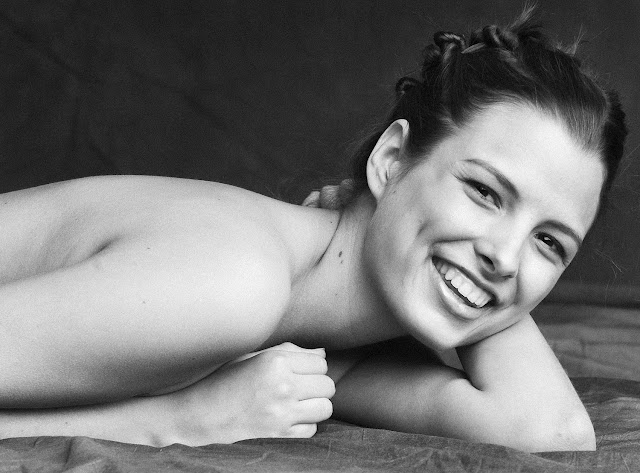Must find more pockets....... Must find bigger pockets......
What in the world is with the latest metrosexual camera obsession called pocketability? I was reading some well reasoned discussions about Olympus Pen and Nikon series 1 cameras and when I started to scroll down through the comments I found entry after entry downgrading the cameras because they can't fit into someone's tight, slim fit, rocker jeans back pocket. Since when was that a concern for real photographers? Pathetic.
So, now a camera has to have fully interchangeable lenses, a complete selection of super fast prime lenses, a fully programmable wireless flash system, a battery that will last for 10,000 actuations+ chimping, amazingly noise free and noise-reduction-artifact-free files up to 12,000 ISO and it must fit into a space smaller than a round can of smoke-less (Skoal?) tobacco in someone's pants pocket in order to be considered anything less than a "fail"? (And while we're at it let's stop with the achingly cliched: "total fail.")
Let's step back and set some ground rules for the family here at the Visual Science Lab.
1. If you honestly feel that the ability to cram a camera into your Levi's pocket along with your car keys is a most vital stat, please don't tell me that or write that in your comments. I will not be able to resist critiquing your education, your taste and your tenuous grasp on sanity and logic.
2. You can have pocketability but you are relegated to cameras where that's the only design imperative. The Canon s95 and s100 and a few of the candy colored Nikon Coolpix cameras come to mind. But we don't really like to talk about cameras here on VSL that don't have, or can't be retrofitted with, a grown-up viewfinder. " Stinky Diaper Hold" is a camera handling technique that's generally thought of derisively around here....
3. Don't expect any serious camera manufacturer to make a workable, interchangeable lens camera that fits in something the size of your pack of cigarettes. Besides, where will you relocate your pack of cigarettes?
4. Let's stop insisting on mutually exclusive design parameters. Are there "serious" pink camera and lens sets? Can you have a camera you can stuff into your wallet WITH an 800mm f2.8 lens on it? I didn't think so. Neither would Einstein have thought so.
5. Speaking of price/performance/size compromises, please, immediately stop slagging the smaller cameras because they won't do noise free performance on par with a Nikon D3. One is $250 the other is $5,000. Don't expect your Fiat 500 to match top speeds with an Aston Martin Rapide either. (almost hit a brand new Rapide today heading toward the coffee shop because I was trying to yank my Hasselblad 500 CM with the 150mm out of the pocket of my Kenneth Cole Slim Fit slacks so I could photograph it!!!! (sounds stupid, doesn't it?)
6. I don't want to hear stories of how you were cheated in the warranty repair process after you realized the crunch you heard as you were sitting down was the camera in your back pocket.
7. If you need a special tool or aftermarket attachment to hold the camera properly then it is too small. If it slips through your Metro shelving and falls onto the floor of your studio then it's too small. If you confuse your iPhone with your camera then the camera is too small. If it slips through the seat cushions of your sofa.....it is too small. Like saving money by buying a Canon 5D mk2 for video and then adding $10,000 worth of Red Rock Micro stuff to it to make it all work....
8. Every time you whine about a camera not fitting into your English rocker pants pockets mystic wood spirits kill another puppy.
9. It's a sickness if your weight hasn't changed but you've switched from buying pants with a waist size of 32 to pants with a waist size of 44 inches just to better carry your "arsenal" of "pocketable" mini-cams.
10. If you insist on panta-looney photography people will make jokes that start with......"Is that a toy camera in your pocket or are you just glad to...........?"
This photo is the minimum assemblage of gear recommended for daily carrying
by the American Association for More Profitable Chiropractors. (AAMPC).
Seriously. I understand that it's great to not carry around a ton of gear in your day to day life but just let a little more testosterone flow into the system and use one of the unobtrusive camera straps that comes free in the camera box. Your camera will be ready when you need it (and where you need it), you won't have to hear lectures from your bespoke tailor about the "bump that's ruining the sinuous line of your trousers." No jokes about dressing "left" or dressing "right." And then, since you saved a bundle getting a tiny camera instead of a reasonable camera, you'll have acres of pocket space left for that dramatic roll of banknotes. If pocket dimensions are an overriding concern then skip the mini-cam and get an iPhone 4-something. Join Jack Hollingsworth in his pursuit to redefine photograph.....one quarter inch sensor at a time.
Hard to believe that some of the same folks who pine for "pocketability" are the same people who rush to the other side of absurdity and put giant, militaristic, nihilist, Goth, Black Rapid Straps on their sane sized cameras......but that's a whole different discussion.



































































